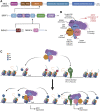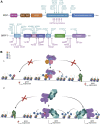The MOZ-BRPF1 acetyltransferase complex in epigenetic crosstalk linked to gene regulation, development, and human diseases
- PMID: 36712963
- PMCID: PMC9873972
- DOI: 10.3389/fcell.2022.1115903
The MOZ-BRPF1 acetyltransferase complex in epigenetic crosstalk linked to gene regulation, development, and human diseases
Abstract
Acetylation of lysine residues on histone tails is an important post-translational modification (PTM) that regulates chromatin dynamics to allow gene transcription as well as DNA replication and repair. Histone acetyltransferases (HATs) are often found in large multi-subunit complexes and can also modify specific lysine residues in non-histone substrates. Interestingly, the presence of various histone PTM recognizing domains (reader domains) in these complexes ensures their specific localization, enabling the epigenetic crosstalk and context-specific activity. In this review, we will cover the biochemical and functional properties of the MOZ-BRPF1 acetyltransferase complex, underlining its role in normal biological processes as well as in disease progression. We will discuss how epigenetic reader domains within the MOZ-BRPF1 complex affect its chromatin localization and the histone acetyltransferase specificity of the complex. We will also summarize how MOZ-BRPF1 is linked to development via controlling cell stemness and how mutations or changes in expression levels of MOZ/BRPF1 can lead to developmental disorders or cancer. As a last touch, we will review the latest drug candidates for these two proteins and discuss the therapeutic possibilities.
Keywords: BRPF1; KAT6A; MOZ; MYST acetyltransferase, MORF; cancer; development; epigenetics.
Copyright © 2023 Viita and Côté.
Conflict of interest statement
The authors declare that the research was conducted in the absence of any commercial or financial relationships that could be construed as a potential conflict of interest.
Figures



Similar articles
-
Molecular architecture of quartet MOZ/MORF histone acetyltransferase complexes.Mol Cell Biol. 2008 Nov;28(22):6828-43. doi: 10.1128/MCB.01297-08. Epub 2008 Sep 15. Mol Cell Biol. 2008. PMID: 18794358 Free PMC article.
-
Molecular insights into the recognition of N-terminal histone modifications by the BRPF1 bromodomain.J Mol Biol. 2014 Apr 17;426(8):1661-76. doi: 10.1016/j.jmb.2013.12.007. Epub 2013 Dec 12. J Mol Biol. 2014. PMID: 24333487 Free PMC article.
-
Expression atlas of the multivalent epigenetic regulator Brpf1 and its requirement for survival of mouse embryos.Epigenetics. 2014 Jun;9(6):860-72. doi: 10.4161/epi.28530. Epub 2014 Mar 19. Epigenetics. 2014. PMID: 24646517 Free PMC article.
-
MOZ and MORF acetyltransferases: Molecular interaction, animal development and human disease.Biochim Biophys Acta. 2015 Aug;1853(8):1818-26. doi: 10.1016/j.bbamcr.2015.04.014. Epub 2015 Apr 25. Biochim Biophys Acta. 2015. PMID: 25920810 Review.
-
The MOZ histone acetyltransferase in epigenetic signaling and disease.J Cell Physiol. 2014 Nov;229(11):1571-4. doi: 10.1002/jcp.24617. J Cell Physiol. 2014. PMID: 24633655 Free PMC article. Review.
Cited by
-
Modulation of the substrate preference of a MYST acetyltransferase by a scaffold protein.J Biol Chem. 2025 Mar;301(3):108262. doi: 10.1016/j.jbc.2025.108262. Epub 2025 Feb 3. J Biol Chem. 2025. PMID: 39909374 Free PMC article.
-
Targeting lysine acetylation readers and writers.Nat Rev Drug Discov. 2025 Feb;24(2):112-133. doi: 10.1038/s41573-024-01080-6. Epub 2024 Nov 21. Nat Rev Drug Discov. 2025. PMID: 39572658 Review.
-
BRPF1 inhibition reduces migration and invasion of metastatic ovarian cancer cells, representing a potential therapeutic target.Sci Rep. 2025 Mar 4;15(1):7602. doi: 10.1038/s41598-025-92438-2. Sci Rep. 2025. PMID: 40038391 Free PMC article.
-
HBO1, a MYSTerious KAT and its links to cancer.Biochim Biophys Acta Gene Regul Mech. 2024 Sep;1867(3):195045. doi: 10.1016/j.bbagrm.2024.195045. Epub 2024 Jun 6. Biochim Biophys Acta Gene Regul Mech. 2024. PMID: 38851533 Review.
-
Chromatin-focused genetic and chemical screens identify BRPF1 as a targetable vulnerability in Taxol-resistant triple-negative breast cancer.Exp Mol Med. 2025 Jun;57(6):1294-1307. doi: 10.1038/s12276-025-01466-5. Epub 2025 Jun 30. Exp Mol Med. 2025. PMID: 40583060 Free PMC article.
References
-
- Ali M., Yan K., Lalonde M. E., Degerny C., Rothbart S. B., Strahl B. D., et al. (2012). Tandem PHD fingers of MORF/MOZ acetyltransferases display selectivity for acetylated histone H3 and are required for the association with chromatin. J. Mol. Biol. 424, 328–338. 10.1016/j.jmb.2012.10.004 - DOI - PMC - PubMed
-
- Antonescu C. R., Sung Y. S., Chen C. L., Zhang L., Chen H. W., Singer S., et al. (2014). Novel ZC3H7B-BCOR, MEAF6-PHF1, and EPC1-PHF1 fusions in ossifying fibromyxoid tumors--molecular characterization shows genetic overlap with endometrial stromal sarcoma. Genes Chromosom. Cancer 53, 183–193. 10.1002/gcc.22132 - DOI - PMC - PubMed
-
- Arboleda V. A., Lee H., Dorrani N., Zadeh N., Willis M., Macmurdo C. F., et al. (2015). De novo nonsense mutations in KAT6A, a lysine acetyl-transferase gene, cause a syndrome including microcephaly and global developmental delay. Am. J. Hum. Genet. 96, 498–506. 10.1016/j.ajhg.2015.01.017 - DOI - PMC - PubMed
Publication types
LinkOut - more resources
Full Text Sources
Research Materials

